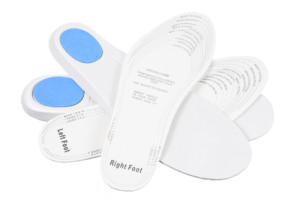 Abraham Lincoln once said, “Be sure you put your feet in the right place, then stand firm.”
Abraham Lincoln once said, “Be sure you put your feet in the right place, then stand firm.”
Lincoln was speaking figuratively. But standing firm and feeling comfortable can be a difficult endeavor. Be kind to your feet; feet that hurt can affect your whole body and certainly ruin your day.
One way of treating your feet well is to choose correct insoles that suit your foot type. They should also match your daily activity and the particular shoes you intend to wear with the insoles. Choosing the wrong insoles can exacerbate any foot problems you may already have. So it’s important to bear a few things in mind when shopping for removable insoles.
Removable insoles can be purchased off-the-shelf, in a specialty shop, or through a podiatrist or other physician. You’ll need to have your foot’s correct measurement to ensure that you select the right size insoles. If possible, give the insoles a try by standing on them before they’re inserted inside a shoe.
Arch Type
No two feet are identical, so a one-size or -type insole just won’t do for all foot types. Before you can choose correct insoles, you’ll need to check out the different arch types to see where yours fit in. Research which are the best support-lending insoles for each arch type:
High arch: If you have high arches, your inner heel and the ball of your foot are taking on the brunt of your body’s weight. So your insoles need to cushion the impact and help distribute that weight more evenly.
Flat feet: Flat feet have a tendency to roll the flattened arch inward with every step (pronation). Insoles that deal best with flat feet are rigid and provide firm, rather than cushioned, support. The goal is to keep the nearly non-existent arch and the entire foot as upright as possible to prevent pronation.
Low to medium arches: A somewhat cushioned, medium-support insole is the best fit for low to medium arches.
Shoe Type
If the new insoles is for an athletic or running shoe, you’ll want to pull out the existing removable insole to check the size. You can also trace an outline of it on a piece of paper that you an take with you when you’re looking for insoles. Less roomy, narrower high-heeled shoes may require partial insoles that are three-quarter or half the size of a full insole. Keep in mind that wearing thick socks can interfere with the fit of insoles inside a running or walking shoe.
Current Foot Ailments
Before you can choose correct insoles, you first need to identify any current problems you might have with your feet.
If you’re feet just tend to hurt or feel achy and tired, select insoles that support and/or absorb shock.
Plantar faciitis, a condition in which a strip of connective tissue has been torn or injured, may benefit from supportive insoles.
Not all foot pain can be relieved with insoles. It’s smart to check with a foot specialist to see if something else is at the root of your foot problems.
Daily Activities
Standing for long periods of time can be brutal on your feet. Choose insoles that are designed for comfort rather than support. For hiking, running, tennis or any activity that requires moving around, select supportive insoles.


